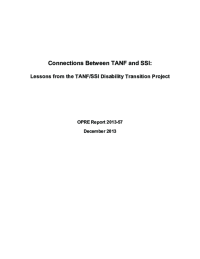Connections Between TANF and SSI
Lessons from the TANF/SSI Disability Transition Project
The Temporary Assistance for Needy Families (TANF) program, administered by the Administration for Children and Families (ACF), serves low-income families, some of which include individuals with disabilities. The Supplemental Security Income (SSI) program, administered by the Social Security Administration (SSA), serves low-income individuals who are aged, blind, or disabled. While ACF and SSA have common goals of supporting vulnerable populations while encouraging their self-sufficiency and employment, the two agencies’ differing missions, definitions of disability, and rules and incentives related to work pose challenges to coordinating their efforts.
In order to understand how best to help TANF recipients with disabilities, ACF and SSA contracted with MDRC and its partners, MEF Associates and TransCen, to conduct the TANF/SSI Disability Transition Project (TSDTP). The goals of the TSDTP are to build knowledge about ways to encourage work among TANF recipients with disabilities, facilitate informed decisions about applying for SSI when appropriate, and help eligible SSI applicants receive awards as quickly as possible while also reducing administrative costs. The TSDTP conducted field assessments of existing services for TANF recipients who may have disabilities, tested pilot programs targeted to this population, and analyzed national- and state-level program data.
This brief summarizes findings from these research activities.
- Analysis of merged TANF and SSI data. The analysis of national-level data found that the overlap between the TANF and SSI populations is not large: in Fiscal Year 2007, less than 10 percent of TANF recipients had open SSI applications, and just 6 percent of adults applying for SSI received TANF benefits within a year before or after they applied. After accounting for differences in basic eligibility characteristics between the two groups, TANF recipients who applied for SSI were slightly less likely to be deemed “disabled,” especially at the initial level, than other SSI applicants. A new analysis of TANF data from five additional states (California, Florida, Michigan, Minnesota, and New York) largely confirms the national-level analysis.
- Field assessments. Field assessments at seven sites found that TANF recipients who are exempt from requirements to participate in work activities due to a disability generally have access to few targeted services designed to increase their self-sufficiency; there is little coordination between TANF programs and SSA during TANF recipients’ SSI application periods; and, at most sites, TANF agencies rely largely on medical professionals to determine TANF recipients’ ability to participate in work activities.
- Pilot interventions. Three counties developed pilot programs designed to address the gaps in services found by the field assessments. Ramsey County, Minnesota, developed a pilot program that targeted employment services to individuals with disabilities, which increased participants’ earnings by 75 percent in its first year. Los Angeles County aimed to facilitate coordination and communication with SSA and improve the quality of SSI applications submitted by TANF recipients in order to increase their initial approval rate. Muskegon County, Michigan, developed an intervention designed to improve the identification of disabilities among TANF recipients and provide enhanced services to TANF clients with disabilities.






